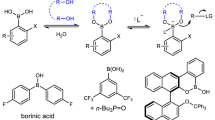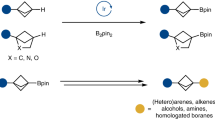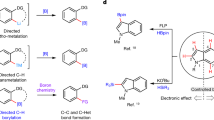Abstract
The expansion of molecular diversity beyond what nature can produce is a fundamental objective in chemical sciences. Despite the rich chemistry of boron-containing heterocycles, the 1,3-dioxa-5-aza-2,4,6-triborinane (DATB) ring system, which is characterized by a six-membered B3NO2 core, remains elusive. Here, we report the synthesis of m-terphenyl-templated DATB derivatives, displaying high stability and peculiar Lewis acidity arising from the three suitably arranged boron atoms. We identify a particular utility for DATB in the dehydrative amidation of carboxylic acids and amines, a reaction of high academic and industrial importance. The three boron sites are proposed to engage in substrate assembly, lowering the entropic cost of the transition state, in contrast with the operative mechanism of previously reported catalysts and amide coupling reagents. The distinct mechanistic pathway dictated by the DATB core will advance not only such amidations, but also other reactions driven by multisite activation.
This is a preview of subscription content, access via your institution
Access options
Access Nature and 54 other Nature Portfolio journals
Get Nature+, our best-value online-access subscription
$29.99 / 30 days
cancel any time
Subscribe to this journal
Receive 12 print issues and online access
$259.00 per year
only $21.58 per issue
Buy this article
- Purchase on Springer Link
- Instant access to full article PDF
Prices may be subject to local taxes which are calculated during checkout




Similar content being viewed by others
References
Jiang, W., Li, Y. & Wang, Z. Heteroarenes as high performance organic semiconductors. Chem. Soc. Rev. 42, 6113–6127 (2013).
Campbell, P. G., Marwitz, A. J. & Liu, S. Y. Recent advances in azaborine chemistry. Angew. Chem. Int. Ed. 51, 6074–6092 (2012).
Baranac-Stojanović, M. Aromaticity and stability of azaborines. Chem. Eur. J. 20, 16558–16565 (2014).
Wang, X. Y., Wang, J. Y. & Pei, J. BN heterosuperbenzenes synthesis and properties. Chem. Eur. J. 21, 3528–3539 (2015).
Bonifazi, D. et al. Boron-nitrogen doped carbon scaffolding: organic chemistry, self-assembly and materials applications of borazine and its derivatives. Chem. Commun. 51, 15222–15236 (2015).
Pattabiraman, V. R. & Bode, J. W. Rethinking amide bond synthesis. Nature 480, 471–479 (2011).
Roughley, S. D. & Jordan, A. M. The medicinal chemist's toolbox: an analysis of reactions used in the pursuit of drug candidates. J. Med. Chem. 54, 3451–3479 (2011).
Dunetz, J. R., Magano, J. & Weisenburger, G. A. Large-scale applications of amide coupling reagents for the synthesis of pharmaceuticals. Org. Process Res. Dev. 20, 140–177 (2016).
Meller, A., Habben, C., Noltemeyer, M. & Sheldrick, G. M. Crystal and molecular structure of 5-p-fluorophenyl-2,4.6-trimethylcyclo-l,3-dioxa-2.4,6-triborane. Z. Naturforsch. B. 37, 1504–1506 (1982).
Oesterle, R., Maringgele, W. & Meller, A. Gezielte synthesen für boroxazine. J. Organomet. Chem. 284, 281–289 (1985).
Suzuki, A. Cross-coupling reactions of organoboranes: an easy way to construct C–C bonds (Nobel lecture). Angew. Chem. Int. Ed. 50, 6722–6737 (2011).
Iwadate, N. & Suginome, M. Differentially protected diboron for regioselective diboration of alkynes: internal-selective cross-coupling of 1-alkene-1,2-diboronic acid derivatives. J. Am. Chem. Soc. 132, 2548–2549 (2010).
Dewar, M. J. S., Kubba, V. P. & Pettit, R. New heteroaromatic compounds. part I. 9-Aza-10-bora-phenanthrene. J. Chem. Soc. 3073–3076 (1958).
Chen, Z., Wannere, C. S., Corminboeuf, C., Puchta, R. & Schleyer, P. V. R. Nucleus-independent chemical shifts (NICS) as an aromaticity criterion. Chem. Rev. 105, 3842–3888 (2005).
Hall, D. G. Boronic Acids: Preparation and Applications in Organic Synthesis, Medicine and Materials 2nd edn (Wiley-VCH, 2011).
Imamura, G. et al. Electronic structure and graphenization of hexaphenylborazine. J. Phys. Chem. C 116, 16305–16310 (2012).
Müller, M., Behnle, S., Maichle-Mössmer, C. & Bettinger, H. F. Boron–nitrogen substituted perylene obtained through photocyclisation. Chem. Commun. 50, 7821–7823 (2014).
Tokunaga, Y. Boroxine chemistry: from fundamental studies to applications in supramolecular and synthetic organic chemistry. Heterocycles 87, 991–1021 (2013).
El-Faham, A. & Albericio, F. Peptide coupling reagents, more than a letter soup. Chem. Rev. 111, 6557–6602 (2011).
Constable, D. J. C. et al. Key green chemistry research areas—a perspective from pharmaceutical manufacturers. Green Chem. 9, 411–420 (2007).
Charville, H., Jackson, D., Hodges, G. & Whiting, A. The thermal and boron-catalysed direct amide formation reactions: mechanistically understudied yet important processes. Chem. Commun. 46, 1813–1823 (2010).
Lanigan, R. M. & Sheppard, T. D. Recent developments in amide synthesis: direct amidation of carboxylic acids and transamidation reactions. Eur. J. Org. Chem. 2013, 7453–7465 (2013).
Lundberg, H., Tinnis, F., Selander, N. & Adolfsson, H. Catalytic amide formation from non-activated carboxylic acids and amines. Chem. Soc. Rev. 43, 2714–2742 (2014).
Zheng, H. & Hall, D. G. Boronic acid catalysis: an atom-economical platform for direct activation and functionalization of carboxylic acids and alcohols. Aldrichmica Acta 47, 41–51 (2014).
Ishihara, K. & Yamamoto, H. Arylboron compounds as acid catalysts in organic synthetic transformations. Eur. J. Org. Chem. 1999, 527–538 (1999).
Ishihara, K., Ohara, S. & Yamamoto, H. 3,4,5-Trifluorobenzeneboronic acid as an extremely active amidation catalyst. J. Org. Chem. 61, 4196–4197 (1996).
Ishihara, K., Kondo, S. & Yamamoto, H. 3,5-Bis(perfluorodecyl)phenylboronic acid as an easily recyclable direct amide condensation catalyst. Synlett 2001, 1371–1374 (2001).
Latta, R., Springsteen, G. & Wang, B. Development and synthesis of an arylboronic acid-based solid-phase amidation catalyst. Synthesis 2001, 1611–1613 (2001).
Arnold, K. et al. To catalyze or not to catalyze? Insight into direct amide bond formation from amines and carboxylic acids under thermal and catalyzed conditions. Adv. Synth. Catal. 348, 813–820 (2006).
Arnold, K., Davies, B., Hérault, D. & Whiting, A. Asymmetric direct amide synthesis by kinetic amine resolution: a chiral bifunctional aminoboronic acid catalyzed reaction between a racemic amine and an achiral carboxylic acid. Angew. Chem. Int. Ed. 47, 2673–2676 (2008).
Al-Zoubi, R. M., Marion, O. & Hall, D. G. Direct and waste-free amidations and cycloadditions by organocatalytic activation of carboxylic acids at room temperature. Angew. Chem. Int. Ed. 47, 2876–2879 (2008).
Adolfsson, H., Lundberg, H. & Tinnis, F. Titanium(IV) isopropoxide as an efficient catalyst for direct amidation of nonactivated carboxylic acids. Synlett 23, 2201–2204 (2012).
Lundberg, H., Tinnis, F. & Adolfsson, H. Direct amide coupling of non-activated carboxylic acids and amines catalysed by zirconium(IV) chloride. Chem. Eur. J. 18, 3822–3826 (2012).
Gernigon, N., Al-Zoubi, R. M. & Hall, D. G. Direct amidation of carboxylic acids catalyzed by ortho-iodo arylboronic acids: catalyst optimization, scope, and preliminary mechanistic study supporting a peculiar halogen acceleration effect. J. Org. Chem. 77, 8386–8400 (2012).
Liu, S. et al. Direct amidation of amino acid derivatives catalyzed by arylboronic acids: applications in dipeptide synthesis. Eur. J. Org. Chem. 2013, 5692–5700 (2013).
Yamashita, R., Sakakura, A. & Ishihara, K. Primary alkylboronic acids as highly active catalysts for the dehydrative amide condensation of α-hydroxycarboxylic acids. Org. Lett. 15, 3654–3657 (2013).
Mohy El Dine, T., Erb, W., Berhault, Y., Rouden, J. & Blanchet, J. Catalytic chemical amide synthesis at room temperature: one more step toward peptide synthesis. J. Org. Chem. 80, 4532–4544 (2015).
Lundberg, H. & Adolfsson, H. Hafnium-catalyzed direct amide formation at room temperature. ACS Catal. 5, 3271–3277 (2015).
Mohy El Dine, T., Rouden, J. & Blanchet, J. Borinic acid catalysed peptide synthesis. Chem. Commun. 51, 16084–16087 (2015).
Tam, E. K. W., Rita, Liu, L. Y. & Chen, A. 2-Furanylboronic acid as an effective catalyst for the direct amidation of carboxylic acids at room temperature. Eur. J. Org. Chem. 2015, 1100–1107 (2015).
Ishihara, K. & Lu, Y. Boronic acid–DMAPO cooperative catalysis for dehydrative condensation between carboxylic acids and amines. Chem. Sci. 7, 1276–1280 (2016).
Chaudhari, P. S., Salim, S. D., Sawant, R. V. & Akamanchi, K. G. Sulfated tungstate: a new solid heterogeneous catalyst for amide synthesis. Green Chem. 12, 1707–1710 (2010).
Bannister, R. M., Brookes, M. H., Evans, G. R., Katz, R. B. & Tyrrell, N. D. A scaleable route to the pure enantiomers of verapamil. Org. Process Res. Dev. 4, 467–472 (2000).
Mylavarapu, R. K. et al. Boric acid catalyzed amidation in the synthesis of active pharmaceutical ingredients. Org. Process Res. Dev. 11, 1065–1068 (2007).
Shinde, G. B., Niphade, N. C., Deshmukh, S. P., Toche, R. B. & Mathad, V. T. Industrial application of the Forster reaction: novel one-pot synthesis of cinacalcet hydrochloride, a calcimimetic agent. Org. Process Res. Dev. 15, 455–461 (2011).
Schafer, G., Matthey, C. & Bode, J. W. Facile synthesis of sterically hindered and electron-deficient secondary amides from isocyanates. Angew. Chem. Int. Ed. 51, 9173–9175 (2012).
Li, J., Lear, M. J. & Hayashi, Y. Sterically demanding oxidative amidation of α-substituted malononitriles with amines using O2 . Angew. Chem. Int. Ed. 55, 9060–9064 (2016).
Marks, P. A. & Breslow, R. Dimethyl sulfoxide to vorinostat: development of this histone deacetylase inhibitor as an anticancer drug. Nat. Biotechnol. 25, 84–90 (2007).
Faivre, S., Demetri, G., Sargent, W. & Raymond, E. Molecular basis for sunitinib efficacy and future clinical development. Nat. Rev. Drug. Discov. 6, 734–745 (2007).
McKeage, K. & Plosker, G. L. Amisulpride. CNS Drugs 18, 933–956 (2004).
Acknowledgements
This work is dedicated to Prof. Stuart L. Schreiber on the occasion of his 60th birthday. This work was supported by a Grant-in-Aid for Young Scientists A (KAKENHI no. 25713002) from the JSPS. N.K. thanks the JSPS for financial support via KAKENHI grant no. JP16H01043 ‘Precisely Designed Catalysts with Customized Scaffolding’. H.N. is a JSPS research fellow. The authors thank T. Kimura for the X-ray crystallographic analysis of 1a, 8a and 9, and they would also like to thank R. Sawa, Y. Kubota and K. Iijima for technical assistance with the analysis of 11B NMR spectra.
Author information
Authors and Affiliations
Contributions
H.N., M.S. and N.K. conceived and designed the experiments. H.N., M.F. and Y.A. performed the experiments and analysed the data. H.N. conducted the density functional theory calculations. H.N., M.S. and N.K. co-wrote the paper.
Corresponding authors
Ethics declarations
Competing interests
The Institute of Microbial Chemistry (BIKAKEN) has filed a patent application on DATB catalysts for general direct amide-forming reactions.
Supplementary information
Supplementary information
Supplementary information (PDF 12634 kb)
Supplementary information
Crystallographic data for compound 1a. (CIF 350 kb)
Supplementary information
Structure factors file for compound 8a. (CIF 587 kb)
Supplementary information
Crystallographic data for compound 9. (CIF 843 kb)
Rights and permissions
About this article
Cite this article
Noda, H., Furutachi, M., Asada, Y. et al. Unique physicochemical and catalytic properties dictated by the B3NO2 ring system. Nature Chem 9, 571–577 (2017). https://doi.org/10.1038/nchem.2708
Received:
Accepted:
Published:
Issue Date:
DOI: https://doi.org/10.1038/nchem.2708
This article is cited by
-
Oxygen transfer reaction of haloalkyl amides catalyzed by phenylboronic acid
Communications Chemistry (2023)
-
Discovery, characterization and engineering of ligases for amide synthesis
Nature (2021)
-
A green chemistry perspective on catalytic amide bond formation
Nature Catalysis (2019)



